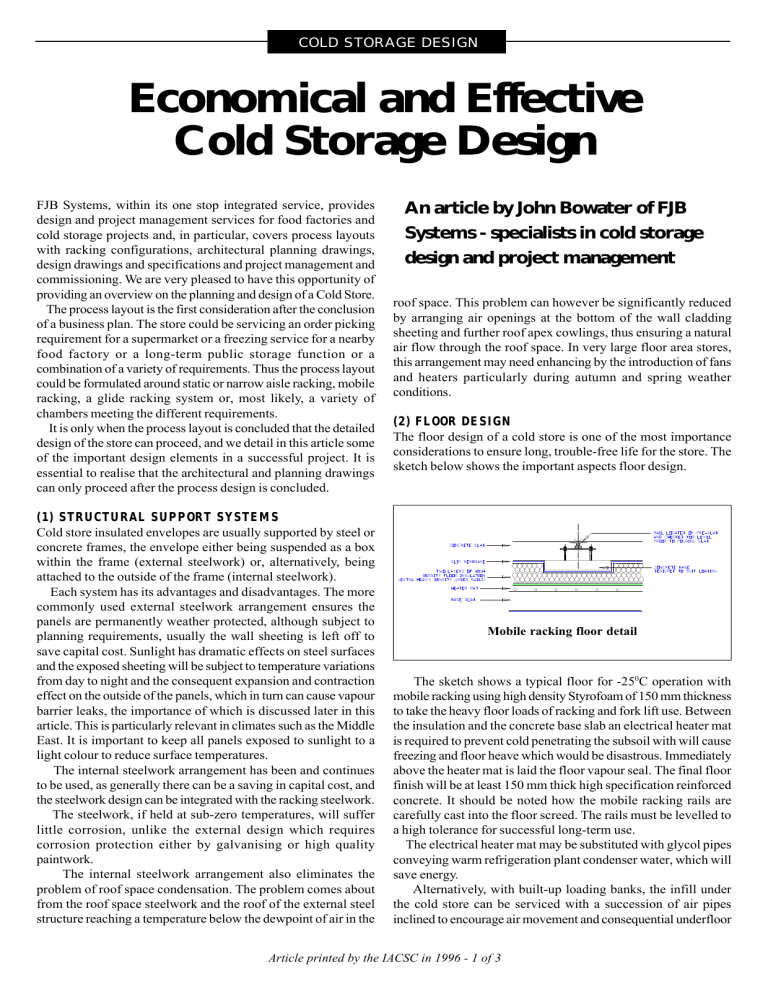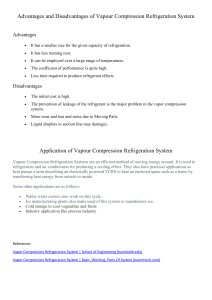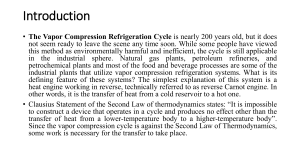
COLD STORAGE DESIGN Economical and Effective Cold Storage Design FJB Systems, within its one stop integrated service, provides design and project management services for food factories and cold storage projects and, in particular, covers process layouts with racking configurations, architectural planning drawings, design drawings and specifications and project management and commissioning. We are very pleased to have this opportunity of providing an overview on the planning and design of a Cold Store. The process layout is the first consideration after the conclusion of a business plan. The store could be servicing an order picking requirement for a supermarket or a freezing service for a nearby food factory or a long-term public storage function or a combination of a variety of requirements. Thus the process layout could be formulated around static or narrow aisle racking, mobile racking, a glide racking system or, most likely, a variety of chambers meeting the different requirements. It is only when the process layout is concluded that the detailed design of the store can proceed, and we detail in this article some of the important design elements in a successful project. It is essential to realise that the architectural and planning drawings can only proceed after the process design is concluded. (1) STRUCTURAL SUPPORT SYSTEMS Cold store insulated envelopes are usually supported by steel or concrete frames, the envelope either being suspended as a box within the frame (external steelwork) or, alternatively, being attached to the outside of the frame (internal steelwork). Each system has its advantages and disadvantages. The more commonly used external steelwork arrangement ensures the panels are permanently weather protected, although subject to planning requirements, usually the wall sheeting is left off to save capital cost. Sunlight has dramatic effects on steel surfaces and the exposed sheeting will be subject to temperature variations from day to night and the consequent expansion and contraction effect on the outside of the panels, which in turn can cause vapour barrier leaks, the importance of which is discussed later in this article. This is particularly relevant in climates such as the Middle East. It is important to keep all panels exposed to sunlight to a light colour to reduce surface temperatures. The internal steelwork arrangement has been and continues to be used, as generally there can be a saving in capital cost, and the steelwork design can be integrated with the racking steelwork. The steelwork, if held at sub-zero temperatures, will suffer little corrosion, unlike the external design which requires corrosion protection either by galvanising or high quality paintwork. The internal steelwork arrangement also eliminates the problem of roof space condensation. The problem comes about from the roof space steelwork and the roof of the external steel structure reaching a temperature below the dewpoint of air in the An article by John Bowater of FJB Systems - specialists in cold storage design and project management roof space. This problem can however be significantly reduced by arranging air openings at the bottom of the wall cladding sheeting and further roof apex cowlings, thus ensuring a natural air flow through the roof space. In very large floor area stores, this arrangement may need enhancing by the introduction of fans and heaters particularly during autumn and spring weather conditions. (2) FLOOR DESIGN The floor design of a cold store is one of the most importance considerations to ensure long, trouble-free life for the store. The sketch below shows the important aspects floor design. Mobile racking floor detail The sketch shows a typical floor for -250C operation with mobile racking using high density Styrofoam of 150 mm thickness to take the heavy floor loads of racking and fork lift use. Between the insulation and the concrete base slab an electrical heater mat is required to prevent cold penetrating the subsoil with will cause freezing and floor heave which would be disastrous. Immediately above the heater mat is laid the floor vapour seal. The final floor finish will be at least 150 mm thick high specification reinforced concrete. It should be noted how the mobile racking rails are carefully cast into the floor screed. The rails must be levelled to a high tolerance for successful long-term use. The electrical heater mat may be substituted with glycol pipes conveying warm refrigeration plant condenser water, which will save energy. Alternatively, with built-up loading banks, the infill under the cold store can be serviced with a succession of air pipes inclined to encourage air movement and consequential underfloor Article printed by the IACSC in 1996 - 1 of 3 COLD STORAGE DESIGN heating. This approach has been found particularly economical in warm climates. 100 mm Thick Panels (Chill Storage use) (3) VAPOUR SEALING Vapour sealing envelopes subject to temperature variations below ambient temperatures is one of the most important requirements in the construction of a cold store. Vapour penetration into the envelope will occur as vapour pressures are lower at lower temperatures and warm air drawn into the envelope will condense its moisture which in turn will form ice, which may damage the panels. Panel penetrations for panel and refrigeration equipment support and the introduction of refrigeration and electrical services must be carefully designed to ensure long-term vapour sealing is maintained for the insulated envelope. What is required for long-term successful operation is to ensure that every joint of the panelling and every penetration is so designed and constructed to ensure that each and everyone of these penetrations are water and vapour tight. The figure below shows the relevant aspects of what is required. Type of Panel U Value w/m20C Weight Installed Cost/m2 (Approx) Possible Water Absorp’n Polystyrene** 0.34 11.2kg/m2 £30 1.0% Styrofoam 0.24 13.3kg/m2 £36 0.5% Polyurethane* 0.20 13.3kg/m2 £38 2.0% Mineral Wool 0.38 19.0kg/m2 £43 50.0% * Significant reduction in U value with ageing ** Since September 11th 2001 Polystyrene & Polyurethane panels attract highly prohibitive insurance penalties. The most commonly used panel for cold storage use is Polystyrene which has been used now since the middle 1960s. It is more economical to erect and is lighter in weight than the other materials. Styrofoam has much higher load bearing characteristics and is therefore mainly used in cold store floors, although the material listed above has recently been developed for panel use. Polyurethane, although expensive, has a better U value but it has been shown that some 15% deterioration in this value can take place over 10 years of use. Polyurethane is used more usually on the European Continent. Mineral wool panels are used in high fire risk situations such as process cooking areas. In our opinion, it is not cost effective to use this material for cold store construction, except for special fire wall requirements. In particular, its ability to absorb water means that a vapour leak could cause excessive ice formation and unacceptable weight increase, if the panel was used throughout the store, and could result in a total ceiling collapse. However, legislators are now attempting to force operators to use mineral wool throughout the whole insulated envelope. The following table provides some indicative costs for a 1 million cu. ft. store built with walls and ceiling in mineral wool panels, compared with conventional Polystyrene units: Sub-zero floor to wall detail Polyurethane % Panel change Mineral Wool Panel £ £ £ £ £ +10% +33% + 0% + 0% + 0% £1,078,000 £ 558,600 £ 400,000 £ 160,000 £ 40,000 +11.8% £2,236,600 This sub-zero floor-to-wall detail relies upon a vapour seal, which is continuous under the floor insulation usually effected by a heavy duty Visqueen which joins a bituthene or equivalent continuous seal which passes under the open end of the wall panel and is lapped around the outside of the panel. Penetrations are required for evaporator supports and electrical wiring and refrigeration pipes. In all cases the best policy is to bore out a sufficiently sized hole in the panel which is then sleeved with a PVC sleeve. The piping, electrical wiring or the support steel is then taken through this sleeve and the penetration is then foamed and sealed with mastic together with a suitable end cap. Note: 11.8% or £236,000 increase in cost using mineral wool panels. Assumes average total store cost £2.00cu.ft. of insulated envelope. Also further saving possible with the use of polystyrene panels. (4) INSULATION PANEL TYPES There is much work proceeding with respect to developing new insulation materials to improve fire risk. Nevertheless, the panels available at present for practical use together with their principle characterisation can be summarised as follows: (5) REFRIGERATION SYSTEMS The refrigeration plant is the heart of a cold storage complex. For practical purposes, the choice of refrigeration design must be made between the following systems: Building works Insulation Refrigeration Electrical Mechanical 980,000 420,000 400,000 160,000 40,000 £2,000,000 Article printed by the IACSC in 1996 - 2 of 3 COLD STORAGE DESIGN (1) Direct expansion DX “Freon” systems R22 (or substitute); R134a: Freon mixtures (2) Pumped refrigerant systems R11 (or substitute); NH3 (3) Pumped NH3 with secondary refrigerant (Glycol). For small cold store boxes, the direct expansion “Freon” plant is low in capital cost and will meet operational requirements. However, for larger plant servicing cold stores of approximately 200,000 cubic feet and upwards, or freezing tunnels, then it is essential that a pumped system should be employed. The following graph explains why: Compressor Power Consumption per kW Refrig Capacity (PkW/kWR) TYPICAL ELECTRICITY CONSUMPTION RESULTS FROM DIFFERENT REFRIGERATION SYSTEMS 1.3 1.2 operated pumped NH3 systems for many years without any serious mishap causing a danger to personnel. The following chart shows a typical 1.5 million cubic foot cold store and freezing plant operation costs: If electricity charges increase by £108,000/year, this increasing operating costs by some 24%, or total costs by 10%. It is quite clear that an operator who opts for the cheap first Operating Costs Rates Personnel Stores Electricity (NH3) system (pumped) Maintenance Miscellaneous Expenses 1.1 1.0 R502 Condensing at +35°C R502 Condensing at +30°C 0.9 Finance Charges 0.8 0.7 Depreciation (15% pa) Interest at 7% R22 Condensing at +35° C R717 Condensing at +30° C 0.6 0.5 0.4 £ 75,000 £ 160,000 £ 10,000 £ 150,000 £ 30,000 £ 20,000 £ 445,000 2 Stage Compression £ 450,000 £ 210,000 £ 660,000 0.3 0.2 0.1 +5 0 -10 -20 -30 -40 -45 COMPRESSOR SATURATED SUCTION TEMPERATURE (°C) The graph shows typical energy consumption figures for single stage R502 plant condensing at 300C and 350C and compares these figures with an industrial NH3 system. R502 is now not used due to the ozone depletion problem, but substitutes now available, if anything, exceed these R502 energy consumption figures. Many refrigeration contractors are forced into quoting such DX systems as the client fails to define his requirements. Such systems are usually built using air cooled condensers for as little as £500/kW refrigeration installed compared with pumped NH3 systems at around £800/kW. However, the DX plant will condense at a temperature with air cooled condensers at least 50C higher than an NH3 system with evaporative condensers. Thus, with a plant designed to operate at -400C suction pressure to deal with carton freezing and storage down to -300C, the pumped NH3 system will consume some 0.62kW electrical consumption/kW refrigeration output compared with approximately 1.07 kW/kW for the economical first cost DX system. For the serious cold store operator, this is simply unacceptable. The table below summarises the approximate cost implications for a typical large storage complex for some 1.5 million cu. ft. operating with freezing tunnels. It can be seen that the electricity costs each year will increase by some £108,000 with the low initial cost DX plant. The NH3 Glycol system should only be used if the operator is forced to abandon a pumped system due to alleged safety reasons. We have System Capital Cost Freon/DX NH3 NH3 £500/kW £800/kW £880/kW Electrical Consumption at -4000C 1.07kW/kW 0.62kW/kW 0.75kW/kW cost DX type plant working with air condensers is placing himself at a complete disadvantage to his competitors. It is essential for the refrigeration plant design to be clearly laid down by the client to competing contractors to ensure the correct plant is tendered and economical ongoing operational costs are achieved. Thus, it is most important to define clearly the requirements of a project be preparing detailed drawings and specifications for all disciplines of a large cold storage design and build contract before tendering. Without such definition, the contractor is forced to quote for plant which has the lowest first cost in order to keep his contracting business in operation. In this respect, the client must take a large share of the responsibility when his project suffers from poor design and workmanship and the operational costs of his factory become uncompetitive due to excessive electricity consumption. Responsible specialist constructors will always ensure a long-term economical project is implemented for clients, in particular with regard to the type of structure to be used to support the insulated envelope, the type of panels that should be used, the way they should be vapour sealed and the type of refrigeration plant that should be installed. With the correct definition of the requirements at the tendering stage of a project, the project will become a success from both a capital and operating cost basis. We would stress one last, final point. To achieve a successful project where all the complicated elements of a cold store must be integrated into a cohesive design, then it is essential to employ a one-stop specialist who appreciates the intricacies of each discipline, i.e. structures, insulation, refrigeration and electrical services. FJB Systems can provide such a service. Typical Store Electricity Cost/year £258,870 £150,000 £181,452 Article printed by the IACSC in 1996 - 3 of 3 Typical Store Capital Cost £375,000 £600,000 £660,000



